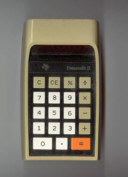
DATAMATH CALCULATOR MUSEUM
 |
DATAMATH CALCULATOR MUSEUM |
When Texas Instruments introduced in September 1971
with the TMS1802 the first "calculator-on-a-chip",
it did not even sport a [=]
key. Its [+=] and [−=] keys clearly demonstrated that the Integrated Circuit
(IC) was designed to
replace adding machines used in offices and not slide rules. Consequently were
these two keys used to accumulate numbers in a register and some calculator
designs even labeled the Clear key with [CA] for Clear Accumulator. With Adding
Machine Logic the [+=] and [−=] keys always complete operations, meaning the key
sequence [2] [x] [3] [+=] [4] [x] [5] [+=] is resulting in 20 from the
evaluation of 4 x 5, the previous calculation of 2 x 3 = 6 was cleared in the
moment the [4] key was pressed.
 The
[K] or [CHAIN-CONST] switch often used
with TMS0100 single-chip calculator circuit designs is using the Constant Mode
to simplify repeating multiplications and divisions but does not affect the
outcome of the key sequence illustrated above. K as in Constant? Not really.
Texas Instruments introduced together with the TMS1802 all major components to
design and build an electronic calculator, including the
TIL360 LED display modules, matching
SN75491 LED segment and
SN75492
digit drivers and 1KS/6KS Klixon™ keyboards. The TMS1802 itself is using
a keyboard scanning logic with 11 outputs and 4 inputs, named KN for the numeral
keys, KO for the operation keys (functions), KP for the decimal position
selector switch and KQ for "other switches", like Constant Mode. For whatever
reasons decided Texas Instruments to mark this switch on the Klixon keyboard
with "K" and since then we know the [K] switch to select the Constant Mode. And
with the instant success of the Bowmar 901B
pocket calculator based on the Texas Instruments "calculator kit", the word was
spreading quickly. Obviously a confusing naming convention and Texas Instruments
used with their first own calculator design, the famous
TI-2500 Datamath, a less confusing
[CHAIN-CONST] label for the switch, yet using the [K] moniker for products
manufactured for third-parties, like the Radio Shack
EC-200. The damage was already
done and even calculators omitting the Klixon keyboard sometimes use a [K]
switch like the Commodore
Minuteman 2.
The
[K] or [CHAIN-CONST] switch often used
with TMS0100 single-chip calculator circuit designs is using the Constant Mode
to simplify repeating multiplications and divisions but does not affect the
outcome of the key sequence illustrated above. K as in Constant? Not really.
Texas Instruments introduced together with the TMS1802 all major components to
design and build an electronic calculator, including the
TIL360 LED display modules, matching
SN75491 LED segment and
SN75492
digit drivers and 1KS/6KS Klixon™ keyboards. The TMS1802 itself is using
a keyboard scanning logic with 11 outputs and 4 inputs, named KN for the numeral
keys, KO for the operation keys (functions), KP for the decimal position
selector switch and KQ for "other switches", like Constant Mode. For whatever
reasons decided Texas Instruments to mark this switch on the Klixon keyboard
with "K" and since then we know the [K] switch to select the Constant Mode. And
with the instant success of the Bowmar 901B
pocket calculator based on the Texas Instruments "calculator kit", the word was
spreading quickly. Obviously a confusing naming convention and Texas Instruments
used with their first own calculator design, the famous
TI-2500 Datamath, a less confusing
[CHAIN-CONST] label for the switch, yet using the [K] moniker for products
manufactured for third-parties, like the Radio Shack
EC-200. The damage was already
done and even calculators omitting the Klixon keyboard sometimes use a [K]
switch like the Commodore
Minuteman 2.
Later members of the TMS0100 single-chip calculator family like
the TMS0119 used with the TI-2500
Datamath calculator, introduced the concept of a separate [=] key to allow mixed
calculations with combinations of addition, subtraction, multiplication and
division in Chain Mode. The calculator will be cleared pressing a number key
after the [=] key. The key sequence [2] [x] [3] + [4] [x] [5] [=] will be
evaluated in the order of its entry and consequently resulting in 50 from the
evaluation 2 x 3 = 6, 6 + 4 = 10 and 10 x 5 = 50. T.
 Later algorithm designs omitted the costly [CHAIN-CONST]
switch and started using the concept of an Automatic Constant, meaning the
answer from a multiplication or division is entered as a Constant with the [=]
key. For practical reasons most implementation use for Multiplications the 1st
operand as a Constant and for Divisions, Additions, and Subtractions the 2nd
operand as a Constant. Here at the Datamath Calculator Museum we annotate this
implementation as M-D-A-S (1-2-2-2). This approach mimics old-school
Multiplication and Division Table Charts used in Elementary Schools all over the
world. The Constant Mode feature simplifies raising a number
to a power and calculating the reciprocal of a number, too.
Later algorithm designs omitted the costly [CHAIN-CONST]
switch and started using the concept of an Automatic Constant, meaning the
answer from a multiplication or division is entered as a Constant with the [=]
key. For practical reasons most implementation use for Multiplications the 1st
operand as a Constant and for Divisions, Additions, and Subtractions the 2nd
operand as a Constant. Here at the Datamath Calculator Museum we annotate this
implementation as M-D-A-S (1-2-2-2). This approach mimics old-school
Multiplication and Division Table Charts used in Elementary Schools all over the
world. The Constant Mode feature simplifies raising a number
to a power and calculating the reciprocal of a number, too.
Example operations for a calculator with M-D-A-S (1-2-2-2) Automatic Constant:
| [3] [x] [2] [=] [=] | 18. |
| [1] [=] | 3. |
| [4] [x] [=] [=] | 64. |
| [3] [:] [2] [=] [=] | 0.75 |
| [1] [=] | 0.5 |
| [4] [:] [=] [=] | 0.25 |
If you have additions to the above article please email: joerg@datamath.org.
© Joerg Woerner, May 29, 2024. No reprints without written permission.